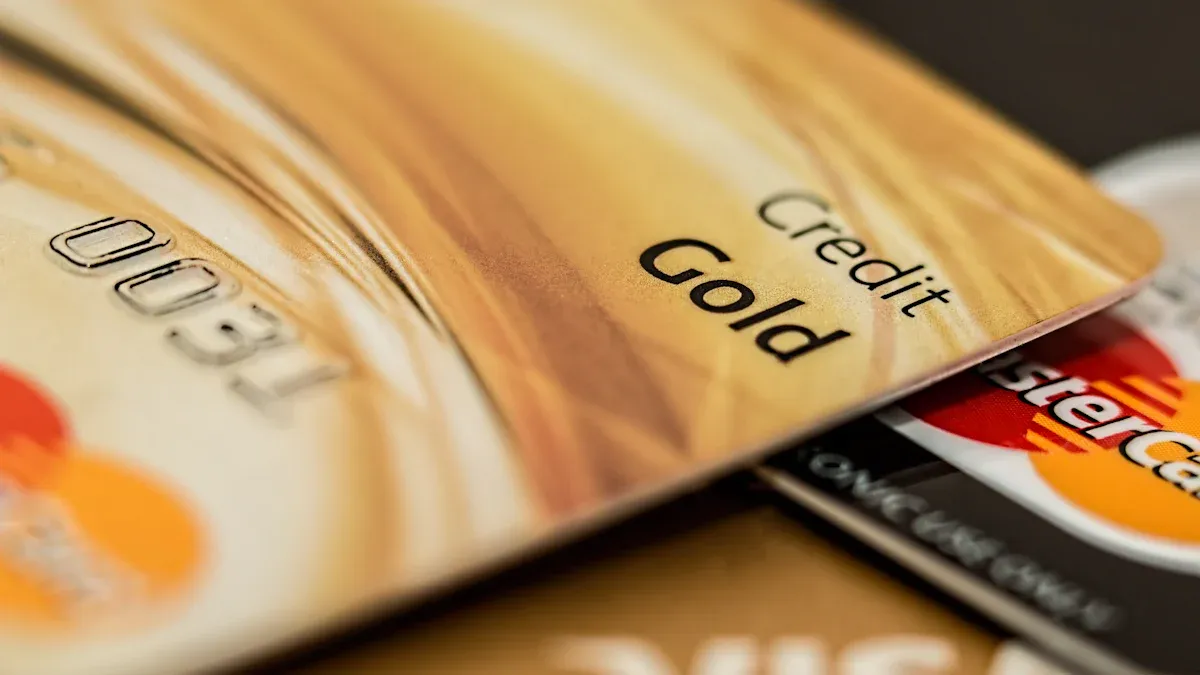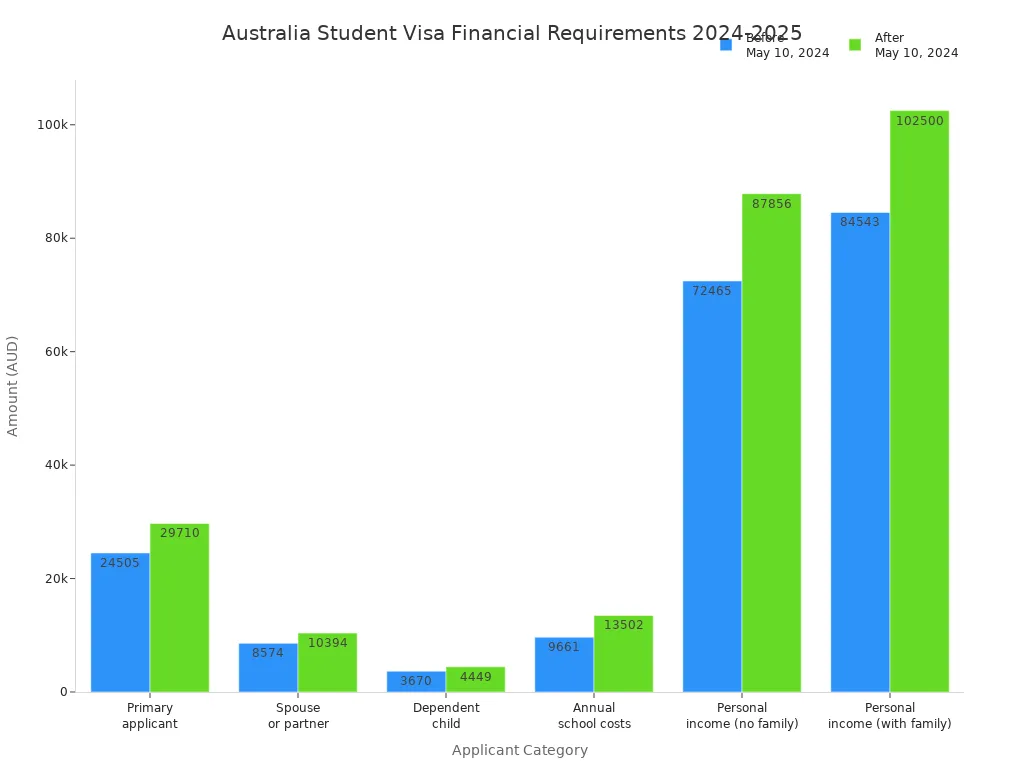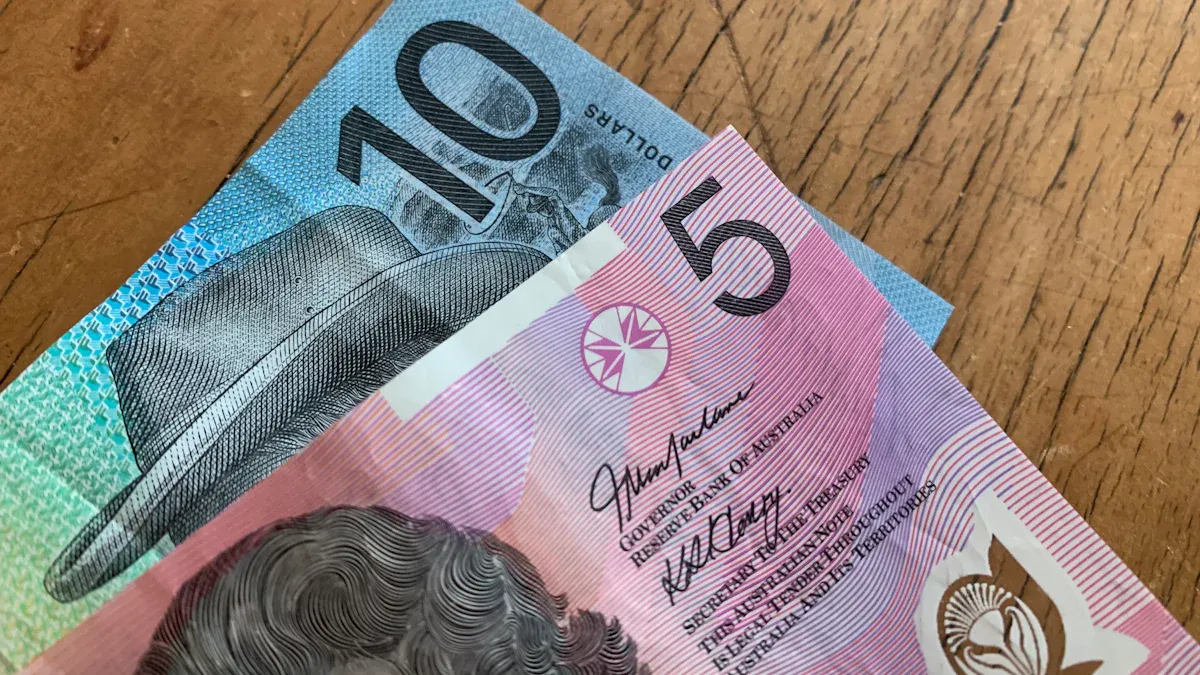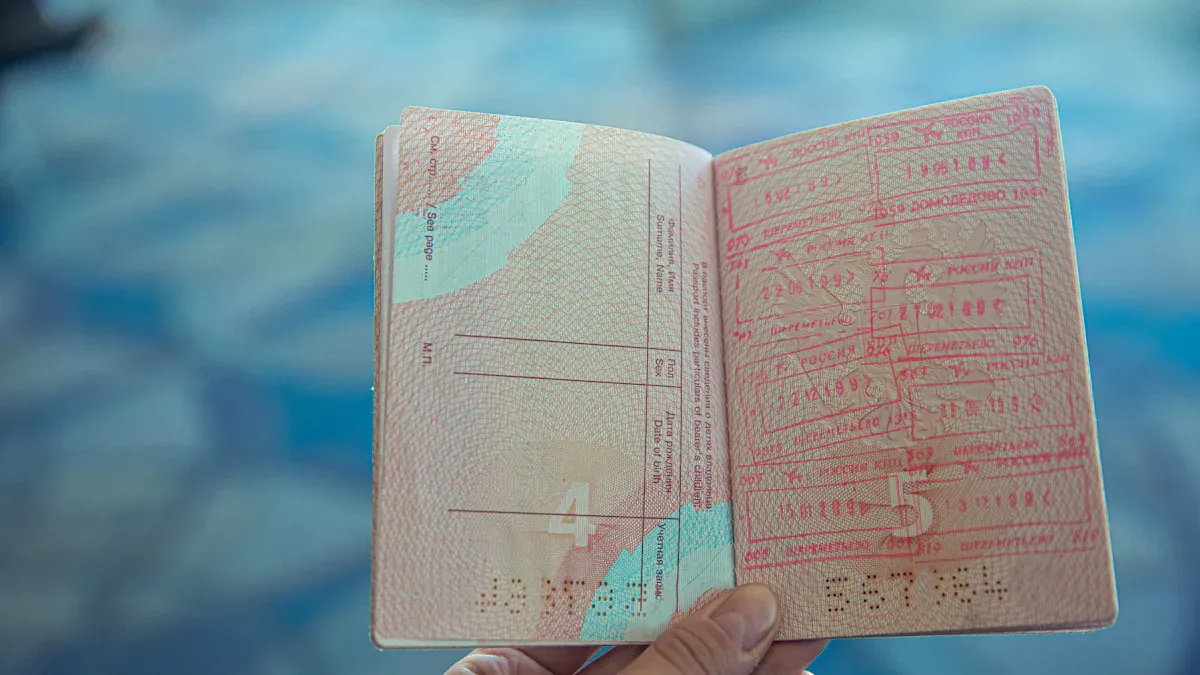- EasyCard
- Trade
- Help
- Announcement
- Academy
- SWIFT Code
- Iban Number
- Referral
- Customer Service
- Blog
- Creator
Understanding Applicant Funds for Supporting Your Stay in Australia

Image Source: pexels
If you plan to study in Australia in 2025, you must show you have enough funds to cover your stay. The Australian government now requires a student to prove at least USD 19,500 (AUD 29,710, using a rate of 1 USD ≈ 1.52 AUD) for a year. For a tourist visa, you should prepare at least USD 3,300 (AUD 5,000) per month. You can see the latest requirements in the table below:
| Category | Minimum Funds (USD) | Minimum Funds (AUD) |
|---|---|---|
| Student (12 months) | 19,500 | 29,710 |
| Spouse or de facto partner | 6,800 | 10,394 |
| Dependent child | 2,900 | 4,449 |
| School costs (per child/year) | 8,900 | 13,502 |

You must meet these financial standards for your visa application. Many students face rejection because they cannot show enough applicant funds or proper documentation. Strong proof of funds increases your chances of getting an Australian visa and helps you focus on your studies.
Key Takeaways
- You must show enough money to cover living costs, tuition, health insurance, and travel when applying for an Australian visa.
- Prepare recent and official financial documents like bank statements, payslips, loan letters, or scholarship certificates to prove your funds.
- Include extra funds for family members, school fees for children, and visa application costs to meet all financial requirements.
- Plan for regional differences in living and travel costs, and always budget more than the minimum to avoid unexpected expenses.
- Organize your documents clearly and provide certified translations if needed to improve your chances of visa approval.
Applicant Funds in Australia

Image Source: pexels
Student Visa Australia: Financial Capacity
You must meet strict financial capacity requirements when you apply for a student visa in Australia. The government updated the minimum financial capacity requirement in May 2024. Now, you need to show at least USD 19,500 (AUD 29,710) for 12 months of living costs as a single student. This amount reflects about 75% of the national minimum wage. If you bring a partner, you must add USD 6,800 (AUD 10,394). For each child, add USD 2,900 (AUD 4,449). School fees for children aged 6-17 are USD 8,900 (AUD 13,502) per year. You also need to show you can pay for your first year of tuition and Overseas Student Health Cover (OSHC) for the entire course.
The financial requirements for a student visa include more than just living costs. You must also budget for tuition, health insurance, and travel. For example, a single student may need to show a total of about USD 37,900 (AUD 57,600) for tuition, OSHC, living, and travel. If you apply as a couple or family, your total required funds will be higher.
Note: The visa application fee for a student visa increased from AUD 710 to AUD 1,600 (about USD 1,050) in 2024. Always check the latest fees before you apply.
Tourist Visa: Sufficient Funds
If you want to visit Australia as a tourist, you must prove you have sufficient funds to cover your stay. The government recommends at least USD 3,300 (AUD 5,000) per month. You can show this with personal bank statements, pay slips, or credit card limits. If a friend or family member in Australia will support you, you must provide a statutory declaration and their financial documents. Authorities may also ask for proof of employment, business registration, or student enrollment to confirm your financial capacity.
Australian authorities use these documents to check if you have enough funds for your stay and departure. They want to see that you will not face financial hardship and that you are likely to return to your home country after your visit.
Regional and Short Course Variations
Living costs in Australia vary by city and region. Major cities like Sydney and Melbourne have higher living expenses than regional areas. You will spend more on accommodation, transportation, groceries, and utilities in big cities. If you choose shared housing or on-campus dorms, your costs may be lower than living independently. You should consider these differences when calculating your applicant funds.
Travel costs also depend on your region. If you apply from East or Southern Africa, you must include USD 1,650 (AUD 2,500) for travel. Applicants from West Africa need USD 2,000 (AUD 3,000). Most other applicants should budget USD 1,300 (AUD 2,000) for travel. If you apply from within Australia, travel costs are lower.
Regional visas have unique requirements. You may need a nomination or sponsorship from a state, territory, or regional employer. You must agree to live, work, and study in a designated regional area. Some regional visas require you to show financial stability to support your initial settlement.
Minimum Funds by Visa Type and Region
| Visa Type / Region | Living Costs (USD) | Living Costs (AUD) | Travel Costs (USD) | Travel Costs (AUD) | Tuition/Other Costs (USD) | Tuition/Other Costs (AUD) |
|---|---|---|---|---|---|---|
| Student (12 months, single) | 19,500 | 29,710 | 1,300 - 2,000 | 2,000 - 3,000 | Varies | Varies |
| Student (partner) | 6,800 | 10,394 | 1,300 - 2,000 | 2,000 - 3,000 | Varies | Varies |
| Student (child) | 2,900 | 4,449 | 1,300 - 2,000 | 2,000 - 3,000 | 8,900 (school fees) | 13,502 (school fees) |
| Tourist (per month) | 3,300 | 5,000 | 1,300 - 2,000 | 2,000 - 3,000 | N/A | N/A |
| East/Southern Africa (travel) | - | - | 1,650 | 2,500 | - | - |
| West Africa (travel) | - | - | 2,000 | 3,000 | - | - |
Additional Costs for Australian Visa Applicants
You must also plan for extra costs when you apply for an Australian visa. These include application fees, health checks, biometrics, and English language tests. The table below shows typical costs in AUD and USD (using 1 USD ≈ 1.52 AUD):
| Cost Type | Description | Cost Range (AUD) | Cost Range (USD) |
|---|---|---|---|
| Visa Application Charge (VAC) | Mandatory fee, varies by visa subclass and applicant | 1,600 (student visa) | 1,050 |
| Health Examination Fees | Required medical checks for some visas | 150 - 550 | 100 - 360 |
| Biometric Collection Fees | Fee for providing biometric data | 60 - 120 | 40 - 80 |
| English Language Testing Fees | IELTS, PTE, TOEFL tests if required | 350 - 450 | 230 - 300 |
| Priority Processing Fees | Optional fee for faster processing | 350 - 2,500 | 230 - 1,650 |

You must include all these expenses in your budget. The government checks your applicant funds to make sure you can cover living costs, tuition, travel, and extra fees. If you do not meet the minimum required funds, your visa application may be refused.
Tip: Always prepare more than the minimum financial capacity requirement. This gives you a safety net for unexpected expenses during your stay in Australia.
Sources of Applicant Funds
Personal Savings and Income
You can use your personal savings and income as applicant funds when applying for a visa to Australia. Immigration authorities accept several types of evidence of financial capacity. You should prepare the following documents:
- Recent bank statements from the last three months, showing consistent balances and deposits.
- Payslips from your employer, covering at least three months.
- Employment contracts or letters confirming your job and salary.
- Income tax returns for the past two to three years.
- Proof of ownership of valuable assets, such as real estate or vehicles.
If you plan to use savings from a Hong Kong bank, make sure the statements are clear and easy to read. All documents must be valid, recent, and translated into English if needed. Avoid submitting outdated or incomplete records. You can also include a detailed travel itinerary and budget estimate to show your planned expenses and adequate financial means.
Tip: If your parents or relatives will support you, you must provide an affidavit of support and their financial documents. The authorities will check the relationship and their ability to provide funds.
Loans, Scholarships, Sponsorships
Loans, scholarships, and sponsorships are also valid sources of applicant funds for your Australia visa. You can use:
- Education loans from registered financial institutions, with official loan certificates and proof of disbursement.
- Scholarships or grants from schools, universities, or government bodies, with official letters stating the amount and duration.
- Sponsorships from parents, legal guardians, or employers, with statutory declarations and proof of financial capacity.
- Bank statements and financial guarantee letters from sponsors.
Australian authorities do not accept cryptocurrency or personal loans from friends as evidence of financial capacity. If you receive a scholarship, you must show that it covers tuition and living costs for at least one year. For sponsorship, the sponsor must provide proof of relationship, income, and commitment to support you.
Genuine Access Requirement
The genuine access requirement is a key part of the visa process for every student. You must show that you can access your applicant funds when you need them. Authorities will check:
- The source of your funds, including bank statements, property deeds, and investment certificates.
- Proof of relationship if someone else provides the funds.
- Evidence of past financial support from your sponsor.
- Documentation for any large deposits or asset sales.
- For loans, the terms, amount, and payment arrangements.
Australian immigration officers look for clear, genuine access to funds. Any doubts about your financial means or inconsistencies in your documents can lead to visa refusal. Always provide complete, accurate, and up-to-date evidence of financial capacity to meet the genuine access requirement.
Sufficient Funds: Proof and Documents

Image Source: pexels
Bank Statements and Payslips
When you apply for a student visa to Australia, you must show clear evidence of financial capacity. Bank statements and payslips are the most common forms of documentary evidence of financial capacity. Australian immigration authorities expect you to provide recent bank statements, usually covering at least three months. These statements should show your name, account number, and a consistent balance. A single statement that is five months old will not meet the requirements. You should include continuous statements from the oldest available up to the most recent date. Payslips must match the salary payments shown in your bank statements. Make sure each payslip includes your employer’s name, payment period, and your own name.
Note: Bank statements must be on official letterhead or stamped by the bank. If you use a Hong Kong bank, ensure the documents are clear and easy to read.
Australian case officers may ask for different amounts of documentation depending on your visa type. For a student visa, you should focus on showing current and verifiable evidence of funds.
Loan and Scholarship Letters
If you use a loan or scholarship to prove sufficient funds, you must provide official letters as documentary evidence of financial capacity. A loan sanction letter should come from a recognized bank. It must confirm the loan amount, interest rate, repayment terms, and details about your university and course. The letter should also mention any collateral or security used for the loan. For scholarships, you need an official letter or certificate that confirms your award. The letter must state the amount, duration, and terms of the scholarship. It should clearly show how the scholarship covers your tuition and living expenses as a student in Australia.
Tip: Always include evidence of disbursement for loans and make sure scholarship letters are signed and stamped by the awarding body.
Tips for Documentation
You can improve your visa application by organizing your financial documents in a clear and logical way. Here are some best practices:
- Structure your Letter of Financial Support with clear sections, such as sponsor details, relationship declaration, and financial commitment.
- Attach a comprehensive evidence pack. Include bank statements, payslips, tax returns, employment verification, and asset documents.
- Provide certified identity documents and proof of relationship if someone else supports you.
- Make sure all documents are recent, official, and translated into English if needed.
- Double-check that your evidence of funds matches the amounts required for a student visa in Australia.
Presenting well-organized and complete documentary evidence of financial capacity helps you show that you have sufficient funds for your stay as a student.
Special Cases in Financial Capacity Requirements
Dependents and Family Members
When you include dependents or family members in your Australia visa application, you must show higher financial support. The government expects you to prove that you can cover the living expenses and travel costs for each person you bring. Here is what you need to prepare:
- Add USD 4,670 (about AUD 7,100) for a partner or spouse.
- Add USD 2,000 (about AUD 3,040) for each child under 6 years old.
- Add USD 5,260 (about AUD 8,000) for each child over 6 years old.
- Include the cost of return flights for every applicant.
You must provide clear evidence of financially supporting the applicant and all dependents. Acceptable documents include bank statements, term deposits, loan certificates, and tax returns from the most recent year. You should also submit a letter of financial support and proof of your relationship with each dependent. If you are a parent, you need to show an ongoing income of about USD 46,000 (AUD 70,000) or a deposit in a financial institution. These requirements increase as you add more family members, so plan your funds carefully.
School-Aged Children
If you plan to bring school-aged children to Australia, you must show extra financial support. You need to provide:
- Proof of financial ability, such as monthly pay slips and bank statements, to cover your child’s expenses.
- Visa application fees for each child, which are about USD 130 (AUD 195).
- Possible extra fees for biometrics, health checks, and passport applications.
- Documents that show you have the legal right to act in your child’s best interest.
You must demonstrate that you can meet all living and educational costs for your children. Immigration officers will check your financial means and your ability to provide ongoing support.
Emergency Support
If you face financial hardship while living in Australia, you can access several emergency support options. Many states offer relief funds and practical help for international students and other visa holders. The table below summarizes available support:
| Visa Category | Government Support | Emergency Support Options |
|---|---|---|
| Student | No direct support | State relief funds, university assistance, superannuation access, food and housing help |
| Visitor | Not eligible | Embassy contact, International Organization for Migration, Homeward Return Program |
| Temporary Worker | Not eligible | Superannuation withdrawal, Red Cross, community organizations |
| Partner | Limited benefits | Medicare, some Centrelink payments, charities |
- Contact the National Debt Helpline for free financial counseling.
- Seek help from charities like the Red Cross or Salvation Army for food and accommodation.
- Apply for no-interest loans for essential items if you qualify.
- Reach out to your embassy, university, or family for additional financial support.
These resources help you manage unexpected challenges and ensure you have the support needed during your stay in Australia.
Tips and Common Mistakes
Frequent Errors
Many applicants for an Australian visa make mistakes that can delay or even stop their plans to study or visit Australia. You might submit bank statements that are not recent or do not cover the required three-month period. Some applicants forget to use official bank letterhead or fail to provide certified translations for documents not in English. If you do not show a steady income or savings, or if you cannot explain large deposits, your application may raise concerns. You should also avoid submitting unverifiable bank documents, especially from Hong Kong banks, and always include supporting documents for fixed deposits. These errors often lead to questions about your ability to support yourself as a student or visitor in Australia.
Note: Outdated or incomplete financial statements, missing minimum financial thresholds, and unverifiable documents are the most common reasons for visa rejection.
Application Success Tips
You can improve your chances of a successful visa application by following a few key steps. First, always submit clear and complete proof of financial support. This includes current bank statements, income tax returns for the past three years, and evidence of fixed deposits or investments. If you are employed, add salary slips. If you run a business, include business registration papers. Make sure all documents are accurate and match the amounts required for your stay as a student in Australia.
- Prepare all financial documents in English or provide certified translations.
- Double-check that your documents are recent and on official letterhead.
- Explain any large or unusual deposits in your bank account.
- Consult a registered MARA agent if you have questions about financial support or document requirements.
Showing strong financial support for tuition, living expenses, and travel costs helps you prove you can support yourself during your stay in Australia.
To secure your visa for Australia, you must show enough funds and provide strong documentation. Prepare these essentials:
- Valid passport and recent photographs
- Proof of financial capacity, such as bank statements and payslips
- Travel itinerary and hotel bookings
- Evidence of employment or business
- Invitation letters if needed
Check the latest government updates before you apply. Careful planning and attention to detail help you succeed with your application.
FAQ
How recent should your bank statements be for an Australian visa application?
You should provide bank statements from the last three months. These statements must show your name, account number, and a consistent balance. Make sure the documents are clear and on official bank letterhead.
Can you use funds from a Hong Kong bank to show financial capacity?
Yes, you can use funds from a Hong Kong bank. You must submit clear, official statements in English. If the documents are not in English, provide certified translations. The statements should show your name and account details.
What happens if you cannot meet the minimum fund requirement?
If you do not meet the minimum fund requirement, your visa application may be refused. You must show enough money to cover living costs, tuition, and travel. Always prepare more than the minimum to avoid problems.
Do you need to show proof of funds for each family member?
Yes, you must show proof of funds for every family member included in your application. Add the required amount for each dependent. Provide supporting documents, such as bank statements and letters of financial support.
Is it possible to use a scholarship as proof of funds for studying in Australia?
You can use a scholarship as proof of funds. Submit an official scholarship letter that states the amount, duration, and what expenses it covers. The letter should show that your scholarship supports your stay in australia.
Meeting Australia’s visa fund requirements, like USD 19,500 for students, can be challenging with high transfer fees and complex processes . BiyaPay, authorized by U.S. and New Zealand regulators, simplifies international transfers with fees as low as 0.5%, supporting 30+ fiat and 200+ digital currencies with transparent rates. Pay in 190+ countries with Biya EasyCard, compatible with Amazon, eBay, and PayPal, with no annual fee. Whether funding tuition or shopping cross-border, BiyaPay ensures secure, low-cost transfers. Pair with travel insurance for full protection—register at BiyaPay today.
*This article is provided for general information purposes and does not constitute legal, tax or other professional advice from BiyaPay or its subsidiaries and its affiliates, and it is not intended as a substitute for obtaining advice from a financial advisor or any other professional.
We make no representations, warranties or warranties, express or implied, as to the accuracy, completeness or timeliness of the contents of this publication.




Contact Us
Company and Team
BiyaPay Products
Customer Services
is a broker-dealer registered with the U.S. Securities and Exchange Commission (SEC) (No.: 802-127417), member of the Financial Industry Regulatory Authority (FINRA) (CRD: 325027), member of the Securities Investor Protection Corporation (SIPC), and regulated by FINRA and SEC.
registered with the US Financial Crimes Enforcement Network (FinCEN), as a Money Services Business (MSB), registration number: 31000218637349, and regulated by FinCEN.
registered as Financial Service Provider (FSP number: FSP1007221) in New Zealand, and is a member of the Financial Dispute Resolution Scheme, a New Zealand independent dispute resolution service provider.




















